The train from Cartagena is eleven minutes late arriving into Alicante and almost twenty minutes behind schedule by the time it leaves for Zaragoza. Not that anyone minds, it is the way of the things and besides most of the passengers are only heading to Valencia. There are youngsters sneaking away on secret trysts, weary academics, families on holiday and old Señoras who are somehow blessed with the loudest voices in Christendom. Heading north west the train leaves the orange groves behind and begins to climb through lush pasture lands of terracotta earth to where the corn sways and the sheep graze and the orchards bear fruit as they have done for centuries. At 3,000 feet above sea level the track sweeps on a long arc and deposits us at the pretty little station of Teruel.
Aragon is an autonomous community in North West Spain comprised of three provinces; Huesca, Zaragoza and Teruel. The latter has a capital of the same name and has the distinction of being the smallest provincial capital in mainland Spain and the only capital to have no direct train route to Madrid.
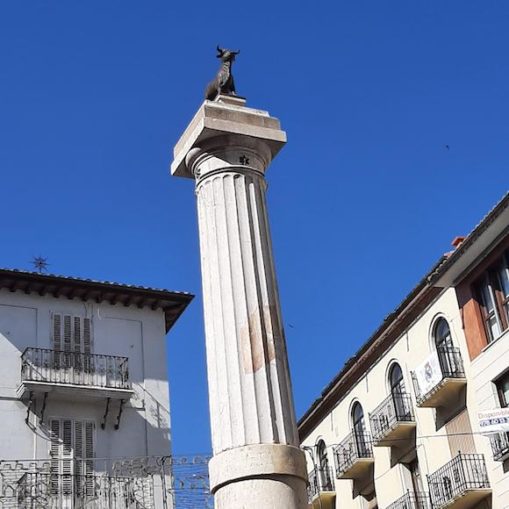
© AÑO NUEVO 2022, Going Postal
The land surrounding Teruel (pronounced Ter’well) has a history dating back to the Celt-Iberians who called the place ITUR + OLU + ETA from a Basque name meaning source of the spring. In AD 762 the Moors conquered Spain and as part of their entourage brought into the region master builders and masons. The areas of Aragon, Castile, Leon and Galicia were conquered and reverted back to Christian rule by the mid-11th century and it is known that a series of Inquisitions by the Catholic Church led to a high number of Muslim builders converting to Christianity. These builders were known as the Mudéjar and throughout the Middle Ages they were engaged by Christian benefactors to build cathedrals and towers. The Arabic word for tower is tirwal and there is conjecture that this is how Teruel got its name. What can be stated with some certainty however is that the town of Teruel was created by King Alfonso II on October 1st 1171 as a means of strengthening the southern border of Aragon against the Almohads who had already taken Valencia.
When King Alfonso II brought the landowners together they opted by omen to build on a site indicated by a bull standing on a hill under a star. The word for bull is toro and the name of the star was Actuel, which when put together forms toro-actuel which can be bastardised to Teruel. The symbol is still used on the town’s crest and epitomised by a bull atop a column rising from a fountain in the main square.
Teruel today is a UNESCO site and is renowned for its Mudéjar architecture, which comprises of four intact towers, a cathedral, a church and the curtain walls of the Vila Vela. It is the most complete set of buildings in the Mudéjar style in Spain and yet, even in Spain, is virtually unknown.
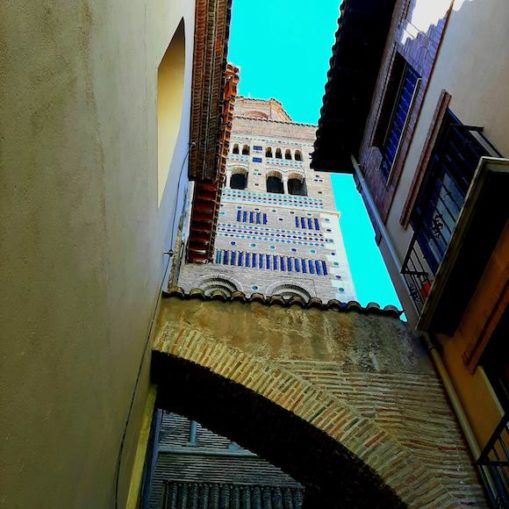
© AÑO NUEVO 2022, Going Postal
The towers themselves are in fact two towers, built one inside the other, with the gap in between taken up by a stone staircase. The interior contains floors at different levels, supported by barrel-vaulted ceilings and are rather plain and rudely constructed. By contrast, the external tower is lavishly decorated in tiles, glass and brick, geometrically placed as to display the Mudéjar style. The earliest tower to be constructed in Teruel is that of the Iglesia de San Pedro completed in the 13th century which was augmented with the Romanesque-Mudéjar church at the beginning of the 14th century. There followed the gate towers of San Martin and San Salvador, also in the 14th century and the Cathedral with Tower in the 15th century. All of the monuments can be visited today, except for the tower of San Martin which is only viewable from the outside.
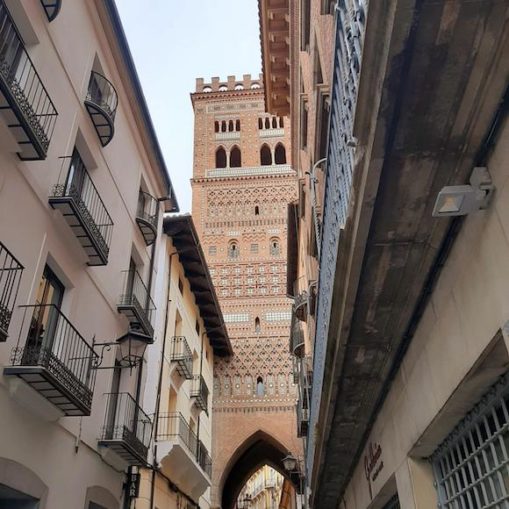
© AÑO NUEVO 2022, Going Postal
After visiting the adjacent 17th-century Baroque church, complete with an amazing carved 13th-century mahogany altarpiece (El Cristo Del Salvador) it was time to climb a tower. I have to confess, not being in the first flush of youth, that there was a certain amount of trepidation involved but the ticket man assured me that one of his best customers was a 90-year-old woman who lived in the town and climbed the tower at least twice a month purely to get some exercise. So I pay the money to risk a coronary and find myself at ground level of the Torre de San Salvador, where compared to the temperature outside it is amazingly cool.
El Torre de San Salvador is more museum than assault course, starting with an informative film about the Mudéjar, with English subtitles. There are also galleries on each floor detailing the history of the tower which assures the climb is not done in a single journey. In fact, it is only the first twenty stairs which are really steep and narrow, so as to protect from invasion, and the rest are relatively shallow by degree.
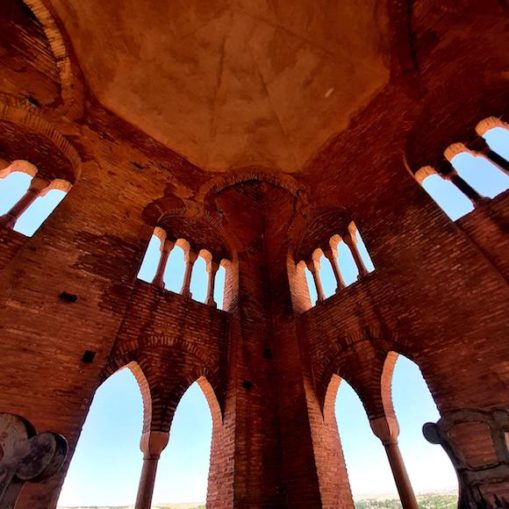
© AÑO NUEVO 2022, Going Postal
Just before reaching the bell tower there is a large notice, written in five languages, giving warning as to when the bells will chime. Apparently the notice is relatively new and is the result of a close shave when a German tourist, suddenly confronted with a huge wall of sound almost fell over the parapet. There are in fact five bells mounted on wooden blocks which announce the hour and half hour, and midday is by far the most deafening hour to visit. That notwithstanding, the views with a 360-degree panorama of Teruel are stunning and none more so than because the bell tower is open and surmounted by an incredible ceiling which seems to amplify the sound. On the descent I pick up on the fact that the internal brickwork is formed from bricks about the same size as Tudor bricks and wonder whether the Mudéjar Tower is not in someway an inspirational piece for the construction of Hampton Court because there are many similarities between Mudéjar and Tudor designs.
On the outskirts of the town there is an aqueduct which once brought water into the Vila Vela of Old Teruel. For all the world it looks Roman and yet on closer inspection it has a high-level water conduit and a lower-level pathway, something that the Romans did not envisage or build.
It was however built as an aqueduct but was designed by a Frenchman called Quinto Pierres Bedel and was constructed between 1537 and 1558 during the great Spanish Renaissance. It is still used today as a walkway between the Old and New Towns and is referred to locally as the French Bridge or the French Aqueduct.
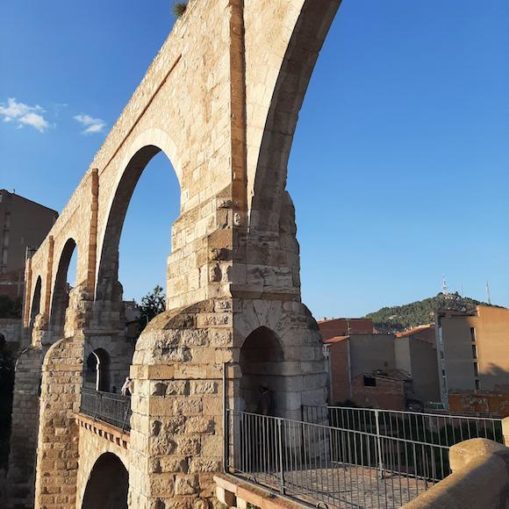
© AÑO NUEVO 2022, Going Postal
In December 1937 the town of Teruel became the scene of some of the fiercest fighting in the Spanish Civil War. Artillery bombardments seriously damaged the outer walls and significantly the towers of Teruel. It is a tribute to the tenacity of the local people, including descendants of the original Mudéjar that the damage has been repaired to leave a unique view of a Mudéjar history in a forgotten but historically important area of Spain. It is also quite telling that there is an enormous sense of pride shown by the residents of Teruel and they readily welcome tourists who have taken the trouble to discover their forgotten corner of Spain. For the most part, these disciples are from the north but significantly untroubled by visitors from the UK who seem not to have discovered the hidden gem that is Teruel.
One of the most visited attractions in Teruel is the Mausoleo de Los Amantes, which is built on the side of the Iglesia de San Pedro to honour the town’s most illustrious former residents, who are also known as the Lovers of Teruel. They were childhood sweethearts from two important families; Isabel a Segura and Juan “Diego” Garces de Marcilla. However, as they were approaching an eligible age, the fortunes of the Marcilla family took a nosedive and the father of Isabel forbade the marriage.
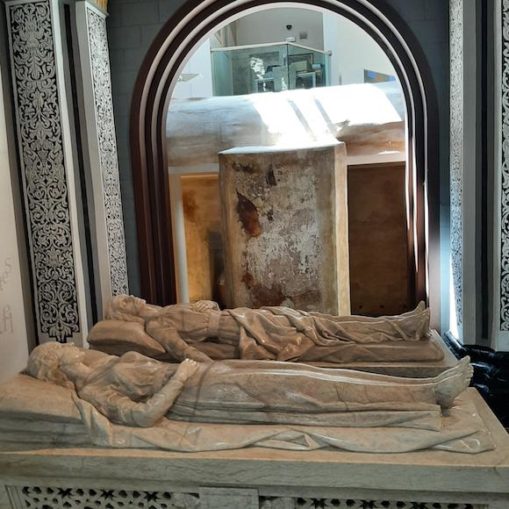
© AÑO NUEVO 2022, Going Postal
To keep his chance of matrimony alive “Diego” pleaded with Isabel’s father and by degrees managed to initiate a plan whereby he would be granted five years to make a fortune or else concede his beloved to marry another. The father agreed. There was then a misunderstanding of what date should be used for the counting of the said five years and having not heard from “Diego” Isabel’s father betrothed her to an heir of the Muslim Taifa kingdom, Don Pedro de Azagra of Albarracin. The wedding was scarce but over when there was a commotion at the Zaragoza Gate and “Diego” returned with a great fortune only to discover his beloved had been wed to another.
That night he crept into the bed chamber of Isabel and Don Pedro and pleaded with his sweetheart for a final kiss which she refused in deference to her wedding vows. Bereft of even a kiss “Diego” breathed his last leaving Isabel to explain to her husband the consequence of the event. Distraught Isabel died four days later and the legend of the Lovers of Teruel was born. The couple, as per the wishes of local dignitaries, were buried in the same grave in hallowed ground of what was to become the cloisters of the Iglesias of San Pedro. The year was 1217. Their story became well known in Aragon and quickly spread across the rest of Spain. It also arrived in Italy courtesy of Boccaccio who in 1353 plagiarised the story and added salacious and lurid accounts for his audience using the title Giralmo e Salvestra. It is also feasible that the story was used again by Italian writer Matteo Bandello, translated into French where it became known to the English poet Arthur Brooke who then wrote a long narrative poem called ‘The Tragical History of Romeus and Juliet’ which Shakespeare used as the principal plot for Romeo and Juliet.
In 1555, during building work, the mummified bodies of Isabel and Diego were rediscovered and given a mausoleum place in the corner of the cloisters, where they enjoyed a new audience who were eager to see the Lovers of Teruel. There they remained until the 1970s when they were removed to their current site in a purpose-built mausoleum under the incredibly beautiful work of the sculptor Juan de Ávalos y Garcia-Taborda. Today “The Lovers” lay side by side in finest marble, reaching out to hold hands but tantalisingly still denied the joy of actually touching.
***
It would be wrong to leave Teruel without mentioning food. Being essentially at the heart of the farming community it produces fruit and vegetables which, when grown at local and manageable levels (and not factory farmed) are flavoursome beyond anything available at the local Tesco’s. There is also a plentiful supply of lamb, comparable if not better than “salt marsh” lamb and at a fraction of the cost charged elsewhere in Spain. The star of the show though is the farm-produced Delice de Teruel, a Serrano Ham which is preserved in less salt for a longer time to provide a sweeter and more wholesome taste. There are also local farm-produced meats and cheeses which are way beyond the quality found in mass-produced fayre and by comparison just as cheap.
When the rest of the world is reduced to eating insects and bugs, in that brief period before Schwab and Gates are ritually disembowelled in the town square at Davos, I will make my way to Teruel and sit in the sun at La Abada Restaurant facing the Mudéjar Cathedral of Santa Maria. Like generations before me I will order a platter of locally produced meats and cheeses which, because of the fact Teruel is a rural backwater, will still be available. I will savour every mouthful and remember the time when the rest of Europe used to be like this before the big corporations took over.
I will taste the Delice de Teruel, the Salchicons and the ewe’s milk cheese, so tart it rattles your fillings; I will drink a fine but vaguely rough red wine produced not five kilometres away and will become mellow on an ice cold vermut. I will round off the meal with poached apricots, dried fruit and a Fresca cheese and vanilla pudding and will think myself fortunate that despite the best efforts of the WEF there are still places where quality and history outweighs the love of money.
I think that that would be pretty damn close to paradise, which is a state of mind and not a place at all.

© AÑO NUEVO 2022, Going Postal
Footnote:
During the Grand Scamdemic of 2019-2022 I was mindful that the governments of the world had conspired to totally shaft their populations through costly and punitive measures that would ultimately have to be paid for. In the Iglesia de San Pedro there is a Mudéjar gargoyle that so perfectly depicts what we see today.
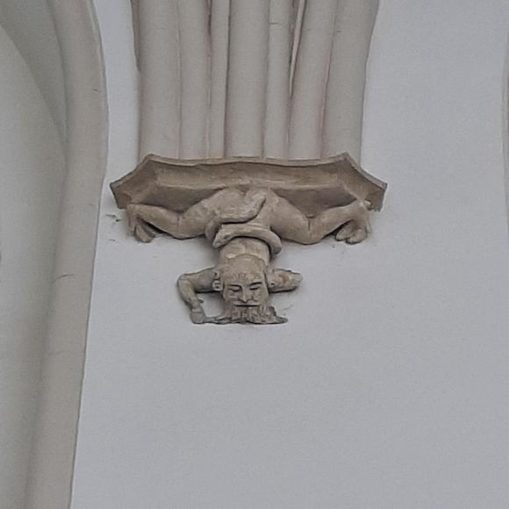
© AÑO NUEVO 2022, Going Postal
© AÑO NUEVO 2022



